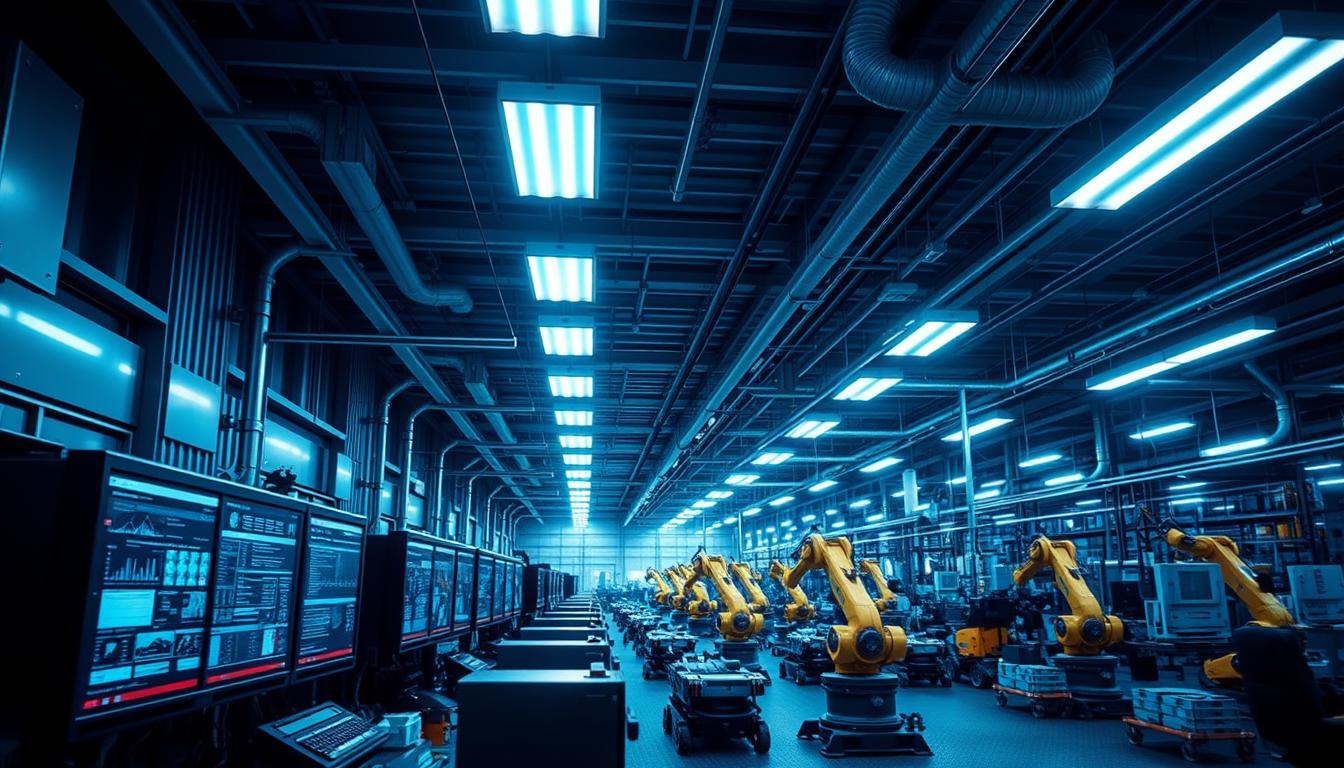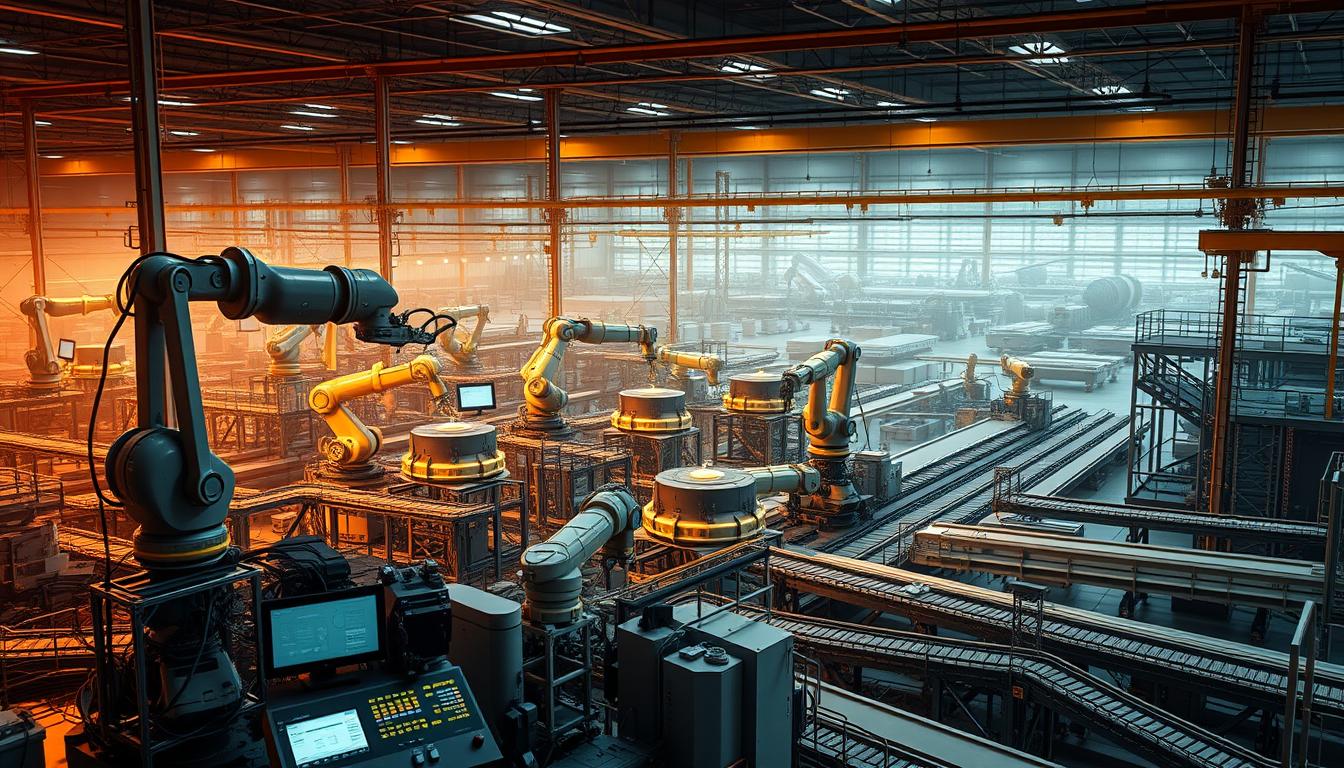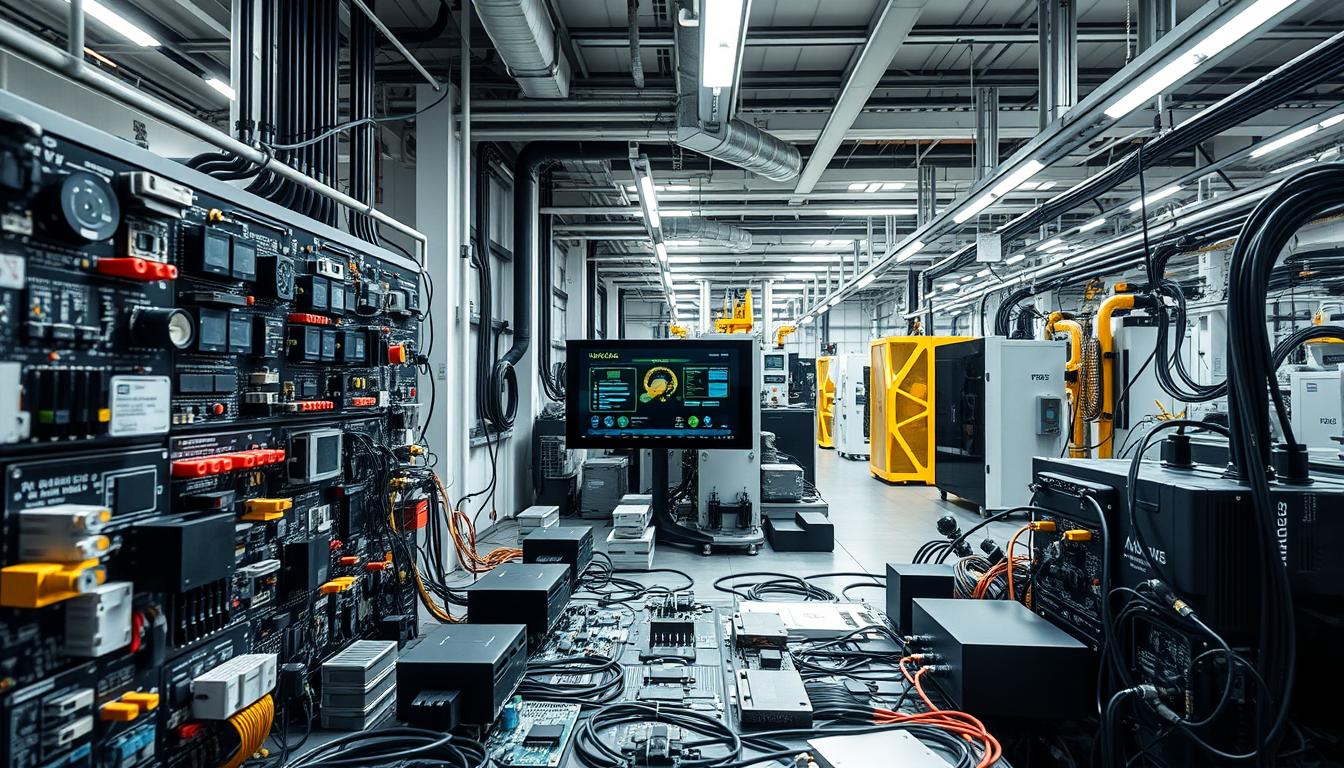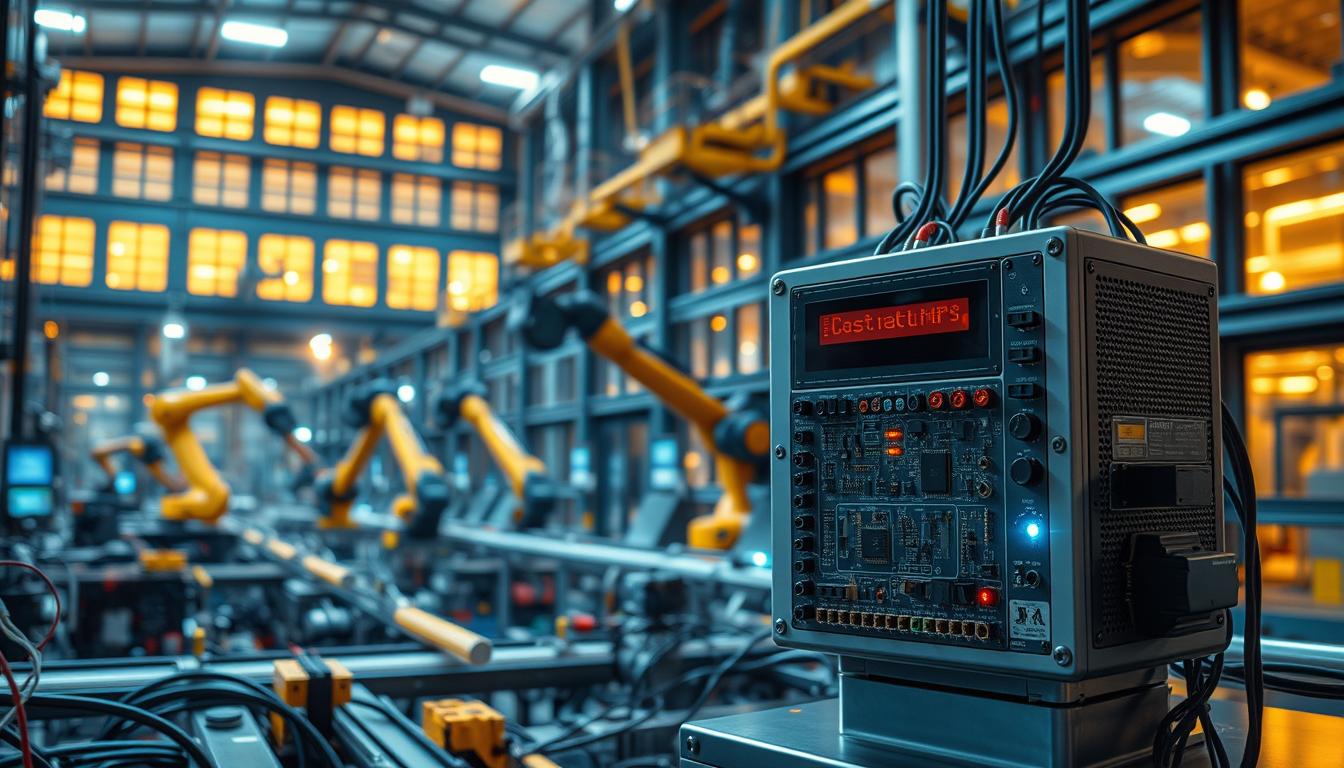Embedded industrial systems: a complete guide
The evolution of industrial electronics is marked by the advent of embedded industrial systems. These technologies are revolutionizing production processes, increasing efficiency and fostering innovation. Syscom-Prorep, with its 30 years of experience, stands out as a leading supplier of industrial electronics and IT solutions.
Embedded systems are integrated into a wide range of devices to perform specific tasks in real time. Made up of microcontrollers, sensors and actuators, they are indispensable in fields such as automotive, healthcare and industry. Their autonomy and ability to network make them crucial to improving safety and quality of life.
The emergence of IoT, AI and machine learning is accelerating the development of embedded industrial systems. With a projected 37 billion IoT connections by 2025, security is becoming a major issue. Quality standards such as ISO 9001 and ISO 26262 are guiding the industry towards reliable, traceable solutions, essential for meeting compliance audit requirements.
Key points to remember
- Embedded systems revolutionize industry and electronics
- They improve efficiency and safety in a variety of sectors
- IoT and AI drive development
- Safety and compliance are top priorities
- Syscom-Prorep offers 30 years of expertise in this field
What is an embedded system: definition and basic concepts
An embedded system is a computer package designed for specific missions. It plays a crucial role in automation and real-time systems. These systems operate autonomously or semi-autonomously, integrated into larger devices.
The essential components of an embedded system
Embedded systems are based on two key elements:
- Microcontrollers: designed for specific tasks, they integrate a processor, memory and interfaces.
- Microprocessors: used in more complex systems, offering high computing power.
Key features of embedded systems
Embedded systems are characterized by :
- Reliability and safety for stand-alone operation
- Optimization in terms of size, cost and consumption
- Fast response times, crucial for industrial automation
- Long-term maintainability
The importance of embedded systems in modern industry
In Industry 4.0, embedded systems are essential. They ensure precise process control, real-time data collection and optimization of operations. Syscom-Prorep offers appropriate solutions, such as LoRa connectivity systems or industrial PCs. These solutions are crucial to the evolution of real-time systems in industry.
Hardware architecture for embedded industrial systems
The hardware architecture of industrial embedded systems is fundamental to industrial IoT. It combines specific components, responding to the unique needs of the industry.
The processors at the heart of these systems can be configured for specific tasks, or work together. Some processors feature extended instructions, essential for complex industrial applications.
Memory management is crucial to performance. The location of data and instructions has a direct influence on execution speed. Processors use virtual addresses, translated into physical addresses by a specialized module.
Industrial sensors are an essential part of this architecture. They collect the data essential for the proper operation of embedded systems, enriching the industrial IoT.
The development of these systems requires specific tools:
- Cross-compilation tools
- Libraries for resource distribution
- Abstract material views
Operating systems are essential. Android, QNX, VxWorks or specialized Linux distributions are frequently used. They manage resources efficiently and facilitate communication between components.
The different types of microcontrollers and industrial microprocessors
In modern industry, microcontrollers and microprocessors are essential. They are at the heart of control and automation systems, particularly SCADA systems. These supervise and manage industrial processes.
Microcontrollers for industrial applications
Microcontrollers are compact integrated circuits. They combine a processor, memory and peripherals. They are available in several versions:
- 8-bit: for simple tasks
- 16-bit: used in medical devices
- 32-bit: for advanced industrial automation
PIC microcontrollers are very compact and popular in robotics. ARM microcontrollers, on the other hand, are versatile and can be found in many industrial systems.
High-performance microprocessors
Microprocessors offer superior computing power. They are ideal for complex applications. We distinguish :
- General-purpose processors: for industrial servers
- DSPs: specialized in signal processing
- GPUs: for intensive graphics rendering
These components are crucial to SCADA systems. They require a high capacity for real-time data processing.
Selection criteria for your project
The choice between microcontroller and microprocessor depends on your application. Energy-saving microcontrollers are ideal for battery-powered devices. More powerful microprocessors are suitable for complex tasks. Clock speed, power consumption and specific functionality will guide your decision to optimize your industrial system.
Real-time operating systems (RTOS) for industry
Real-time systems are essential in modern industry. They enable precise management of critical tasks, guaranteeing fast, reliable response. Zephyr RTOS stands out for its versatility and outstanding performance.
Zephyr RTOS is specially designed for industrial embedded systems. It operates with a small memory footprint, requiring less than 8 Kb of Flash and 5 Kb of RAM. This lightness makes it an ideal choice for devices with limited resources.

Zephyr's compatibility with over 450 development boards, including Arduino and Raspberry Pi, offers great flexibility. It supports various hardware architectures, from Cortex-M to x86_64, adapting to a wide range of industrial use cases.
Security is paramount in real-time systems. Zephyr incorporates robust features such as secure startup and encryption. It complies with industry certifications, notably IEC 61508 SIL 3, guaranteeing the reliability of embedded software.
RTOS optimize task scheduling and resource management. They reduce processor utilization, improving efficiency and lowering operating costs. With robust recovery mechanisms, they ensure safe operation and minimize downtime, essential for industrial productivity.
Programming embedded industrial systems
Programming is fundamental to the development of industrial embedded systems. Embedded software is essential for precise control of numerical controls. They also optimize industrial processes.
Common programming languages
Several languages are used to design efficient embedded software:
- C: Preferred for speed and resource control
- C++: Appreciated for its object-oriented programming
- Java: Preferred for its portability
- Assembler: Used for total system control
- Python: Popular for its accessibility and libraries
Development environments (IDEs)
IDEs are crucial for the creation of embedded software. STM32CubeIDE and Keil µVision are popular choices. They enable developers to efficiently program digital controls for industrial systems.
Good coding practices
Well-structured code is crucial for reliable embedded systems. The book Industrial Embedded Systems: A Complete Guide provides practical examples. It shows, for example, the application of programming concepts in a home heating management system. These best practices guarantee the efficiency and maintainability of embedded software in industry.
Connectivity solutions for embedded systems
Industrial IoT is transforming industrial electronics by introducing advanced connectivity solutions for embedded systems. These technologies ensure smooth communication and seamless integration into today's industrial environment.

Connected embedded systems are revolutionizing industry by enabling real-time data collection and process monitoring. Edge Computing reduces latency and bandwidth requirements, improving the performance of industrial systems.
The most widely used connectivity technologies include :
- LoRa: ideal for long-range, low-power communications
- GNSS: for precise geolocation of equipment
- Wi-Fi: offering high-speed wireless connectivity
- Bluetooth: for short-range, energy-saving connections
These solutions enable embedded systems to integrate seamlessly into the industrial IoT. They facilitate remote monitoring and informed decision-making. By 2025, 75 billion IoT devices are expected to be connected, underlining the growing importance of these technologies in Industry 4.0.
Security is paramount in this connected environment. The use of advanced security protocols and the containerization of software components enhance protection against cyber threats. This guarantees the reliability and integrity of embedded industrial systems.
Safety and reliability of embedded industrial systems
Safety and reliability are crucial aspects of industrial embedded systems. In the context of industrial automation, they are essential to avoid costly downtime and data breaches.
Safety protocols
Embedded industrial systems require robust protection. Data encryption, secure authentication and secure communication protocols are essential. In the face of constantly evolving threats, it is vital to integrate cybersecurity right from the design stage.
Redundancy strategies
The reliability of industrial embedded systems relies on the identification of potential failure modes. Redundancy and fault tolerance techniques are crucial. Taking into account environmental and operational stress factors ensures continuous operation of industrial automation.
Industrial certifications
Industry certifications ensure compliance with security and quality standards. They validate the implementation of clear security policies and mechanisms such as firewalls. These certifications are essential to guarantee the reliability of embedded industrial systems in complex automation environments.
Industry 4.0 applications and use cases
Industry 4.0 is radically transforming production methods, integrating cutting-edge technologies. Embedded systems are key to this revolution, driving advanced automation and the emergence of industrial IoT.
Industrial automation
Industrial automation relies on embedded systems to optimize production processes. Factory robots, equipped with intelligent sensors, handle delicate operations such as assembly and quality control. This enhanced automation boosts productivity and reduces human error.
Industrial IoT
Industrial IoT links machines, sensors and systems to analyze data in real time. This data is used to optimize processes, predict breakdowns and increase energy efficiency. For example, sensors continuously monitor the status of industrial equipment.

Predictive maintenance
Predictive maintenance uses data analysis to predict breakdowns before they occur. Artificial intelligence algorithms analyze the data collected to identify anomalies and plan interventions. This strategy reduces downtime and extends equipment life.
Industry 4.0 opens up vast horizons for innovation. Digital twins simulate processes to optimize them. Augmented reality improves training and maintenance. 3D printing enables customized production in small batches. These advances are transforming the industrial sector, making it more flexible and competitive.
Trends and innovations in industrial embedded systems
Embedded industrial systems are evolving rapidly, revolutionizing Industry 4.0. Industrial IoT is progressing at an accelerating pace, with connected devices increasing from 15 billion in 2018 to 80 billion in 2020. This expansion is accelerating innovation, affecting smart objects, digital trust and future transportation.
Programming languages such as C, C++, Python and C# are becoming essential for advanced development. ARM Cortex-M, PIC, AVR and STM32 microcontrollers gain in popularity. FreeRTOS and Eclipse ThreadX real-time operating systems are adopted for efficient real-time operations.
Connectivity is at the heart of our innovations. Wi-Fi, Bluetooth, Zigbee, LoRA, LTE and 5G technologies are integrated to improve communication between systems. The emphasis is on security and automatic updates to guarantee system reliability.
Concrete applications are multiplying. In hospitals, autonomous robots deliver meals and medication. The manufacturing industry uses collaborative robotic arms for tasks such as sanding and polishing. These innovations are opening up new possibilities in industrial automation and industrial IoT.
Embedded systems integration and maintenance
The integration and maintenance of embedded systems play a fundamental role in industrial electronics. These operations guarantee the durability and performance of equipment, which is essential for real-time systems.
Integration methodologies
A methodical approach is required for the integration of embedded systems. Companies generally follow a structured approach, including planning, testing and validation. This strategy ensures smooth integration into complex industrial environments.

Maintenance strategies
Preventive maintenance is essential for industrial embedded systems. It includes periodic inspections, software updates and early replacement of components. This approach reduces downtime and extends equipment life.
Updates and evolutions
Updates are essential to maintain the performance of embedded systems. They rectify bugs, reinforce security and introduce new functionalities. Configuration management is crucial for managing these evolutions and ensuring version traceability.
The sector generates 73 billion euros in revenues in France, underlining the growing importance of integration and maintenance. Professionals need to master these areas to meet the challenges of Industry 4.0 and industrial IoT.
Conclusion
Embedded industrial systems have become an essential part of modern automation. Their evolution from isolated systems to interconnected networks opens the way to new applications. This development underlines the crucial importance of safety from the earliest design phases.
The growing complexity of embedded systems, particularly in critical areas such as automotive electronics, calls for a holistic approach. It is essential to understand and model threats correctly. This guarantees the reliability and security of these systems. Specialized conferences such as CHES, HOST or CryptArchi play a key role in advancing knowledge of embedded system security.
In conclusion, the future of embedded industrial systems lies in our ability to meet these safety challenges while fully exploiting their potential for innovation. For more information on integrating secure embedded systems into your industrial automation project, please contact us on +33 1 23 45 67 89.
FAQ
What is an embedded industrial system?
An embedded industrial system is a computer system integrated into industrial equipment or machinery. It is designed to perform specific tasks in real time. It ensures high reliability, often under difficult conditions. These systems are crucial for automation and industrial IoT.
What are the essential components of an embedded industrial system?
Key components include microcontrollers, industrial sensors and communication interfaces. Memory and a real-time operating system (RTOS) are also essential. Hardware architecture must be robust and adapted to industrial conditions.
What are the main features of industrial embedded systems?
These systems operate in real time and are highly reliable. They are robust in the face of harsh environmental conditions. They consume little energy and integrate well with larger systems such as SCADA.
What programming languages are commonly used for industrial embedded systems?
C and C++ are the most widely used languages, for their efficiency and low-level control. Python is also popular for certain applications. Numerical control programming often uses specific languages.
What is an RTOS and why is it important in industrial systems?
An RTOS is an operating system for tasks with precise time constraints. It is crucial in industrial systems. It guarantees the execution of critical operations within specific deadlines, essential for many industrial processes.
What are the current connectivity solutions for embedded industrial systems?
Common solutions include LoRa, GNSS, Wi-Fi, Bluetooth, and specific industrial protocols. These technologies facilitate integration into the industrial IoT. They enable real-time communication and data exchange.
How can we ensure the safety of embedded industrial systems?
Security is ensured by robust authentication protocols and data encryption. Firewalls are in place, and trusted execution environments (TEEs) are used. Containerization of software components also enhances security.
What role do embedded systems play in Industry 4.0?
Embedded systems are essential to Industry 4.0. They enable advanced industrial automation and the collection of real-time data analysis. They are crucial for creating smart factories and optimizing production processes.
What are the emerging trends in industrial embedded systems?
Trends include the integration of artificial intelligence and machine learning. Systems are becoming more miniaturized and energy-efficient. Computing power is increasing to process complex data on site.
How are industrial embedded systems maintained?
Maintenance includes preventive and corrective strategies. It involves regular firmware updates and physical inspections. Analysis of data collected by industrial sensors is increasingly used for predictive maintenance.

